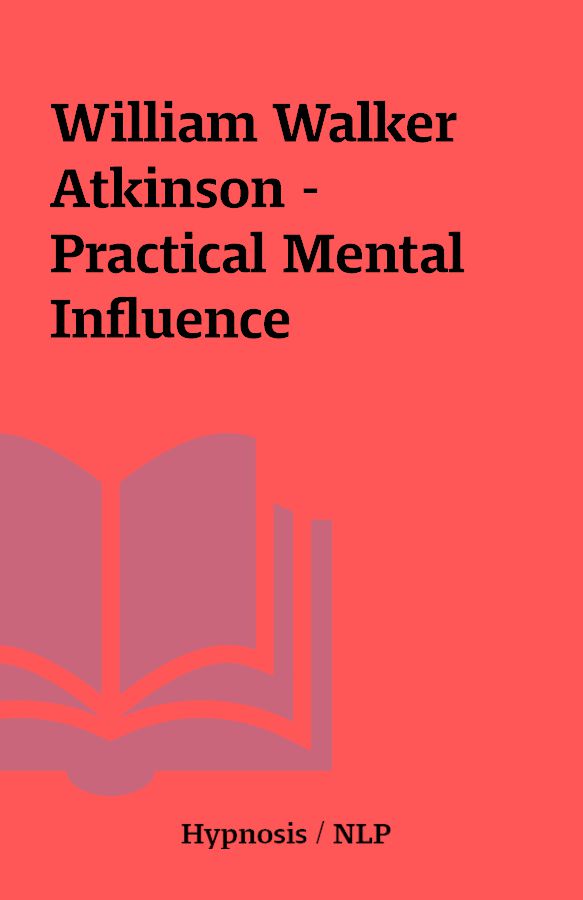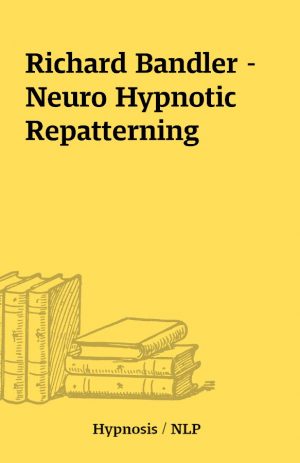William Walker Atkinson – Practical Mental Influence
William Walker Atkinson – Practical Mental Influence
[Audiobook – 12 MP3s]
Description
William Walker Atkinson – Practical Mental InfluenceReader ReviewThis interesting work from 1908 takes quite a practical approach to the idea of mind power. Whereas most of the early New Thought metaphysicians tend to write in the mystical tradition, Atkinson seems to concentrate on explaining mental phenomena from an angle where science meets the occult.He starts out with the law of vibration by first demolishing the tenets of materialism and then by comparing mental power to scientific theories of vibration with analogy to sight and sound. He claims that there exists a scientific explanation behind the beliefs of mental science, beliefs that belong in the field of physical science more than in metaphysics. Atkinson quotes some of the scientists of his own time in support of what was then known about vibrationary rates.He explains the different types of thought waves and the atmospheres that seem to inhabit places. The two main factors in the manifestation of mental influence are concentration and mental imaging, both of which the author explores in detail. He also discusses the two general forms of the use of mental influence that he calls “fascination” and “hypnotism.” Influencing at a distance, like distance healing, is also covered.A particularly interesting chapter is the one on mass influencing, where certain ideas and beliefs can spread far and wide amongst large sections of a population. Atkinson also points out how advertising and sales techniques draw upon this ancient knowledge of thought power. He then shows how vitally important it is for the individual to be resistant or at least aware of the various currents of ideas prevalent at any given time.He discusses white and black magic and concludes the book with a chapter on psychic protection. He urges the reader to look up to the higher self for aid and strength in order to avoid being affected by the waves of feeling or emotion sweeping over the public mind, which have a tendency to stampede people into adopting certain ideas. By affirming the flame of the spirit of the great I Am within, the individual can protect her or himself and remain firmly rooted in a healthy state of independence.Atkinson ‘s insight is timeless. Considering that this book was published in 1908 with the tragic 20th century still to come, many of his ideas were ahead of their time and strangely prescient. The science of quantum physics has only added to the legitimacy of his wise words insofar as it confirms that everything is energy.As mentioned before, Atkinson takes a very practical approach to explaining the mechanics of thought power and in this way appears to lean to the occult side of esoteric science more than the mystical. I do not mean this in a negative way, as his observations and conclusions are similar to those of the other early teachers of New Thought. He is certainly an advocate of what William James called The Religion of Healthy Mindedness.Atkinson’s contribution in this book is particularly valuable in explaining how fashions, trends and certain good or evil thought patterns can spread around the world, how susceptible the individual is, and what one can do to stay immune. I highly recommend this thought provoking book.About William Walker AtkinsonWilliam Walker Atkinson (December 5, 1862 – November 22, 1932) was an attorney, merchant, publisher, and author, as well as an occultist and an American pioneer of the New Thought movement. He is also known to have been the author of the pseudonymous works attributed to Theron Q. Dumont, Swami Panchadasi and Yogi Ramacharaka and others.Due in part to Atkinson’s intense personal secrecy and extensive use of pseudonyms, he is now largely forgotten, despite having obtained mention in past editions of Who’s Who in America, Religious Leaders of America, and several similar publications—and having written more than 100 books in the last 30 years of his life. His works have remained in print more or less continuously since 1900.William Walker Atkinson was born in Baltimore, Maryland on December 5, 1862, to William and Emma Atkinson. He began his working life as a grocer at 15 years old, probably helping his father. He married Margret Foster Black of Beverly, New Jersey, in October 1889, and they had two children. The first probably died young. The second later married and had two daughters.Atkinson pursued a business career from 1882 onwards and in 1894 he was admitted as an attorney to the Bar of Pennsylvania. While he gained much material success in his profession as a lawyer, the stress and over-strain eventually took its toll, and during this time he experienced a complete physical and mental breakdown, and financial disaster. He looked for healing and in the late 1880s he found it with New Thought, later attributing the restoration of his health, mental vigor and material prosperity to the application of the principles of New Thought.Some time after his healing, Atkinson began to write articles on the truths he felt he had discovered, which were then known as Mental Science. In 1889, an article by him entitled “A Mental Science Catechism,” appeared in Charles Fillmore’s new periodical, Modern Thought.By the early 1890s Chicago had become a major centre for New Thought, mainly through the work of Emma Curtis Hopkins, and Atkinson decided to move there. Once in the city, he became an active promoter of the movement as an editor and author. He was responsible for publishing the magazines Suggestion (1900–1901), New Thought (1901–1905) and Advanced Thought (1906–1916).In 1900 Atkinson worked as an associate editor of Suggestion, a New Thought Journal, and wrote his probable first book, Thought-Force in Business and Everyday Life, being a series of lessons in personal magnetism, psychic influence, thought-force, concentration, will-power, and practical mental science.He then met Sydney Flower, a well-known New Thought publisher and businessman, and teamed up with him. In December, 1901 he assumed editorship of Flower’s popular New Thought magazine, a post which he held until 1905. During these years he built for himself an enduring place in the hearts of its readers. Article after article flowed from his pen. Meanwhile he also founded his own Psychic Club and the so-called “Atkinson School of Mental Science”. Both were located in the same building as Flower’s Psychic Research and New Thought Publishing Company.Atkinson was a past president of the International New Thought Alliance.Throughout his subsequent career, Atkinson wrote and published under his own name and many pseudonyms. It is not known whether he ever acknowledged authorship of these pseudonymous works, but all of the supposedly independent authors whose writings are now credited to Atkinson were linked to one another by virtue of the fact that their works were released by a series of publishing houses with shared addresses and they also wrote for a series of magazines with a shared roster of authors.
You must be logged in to post a review.






Reviews
There are no reviews yet.